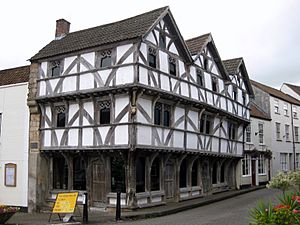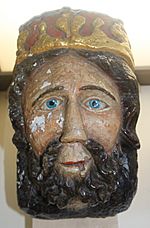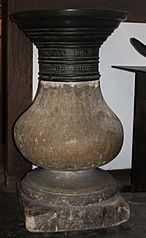King John's Hunting Lodge, Axbridge facts for kids
Quick facts for kids King John's Hunting Lodge, Axbridge |
|
|---|---|

King John's Hunting Lodge
|
|
| Location | Axbridge |
| Area | Somerset |
| Built | 1460 |
| Architectural style(s) | Timber-frame |
| Governing body | Axbridge and District Museum Trust |
| Owner | National Trust |
|
Listed Building – Grade II*
|
|
| Official name: King John's Hunting Lodge (Axbridge Museum) | |
| Designated | 9 February 1961 |
| Reference no. | 1059142 |
| Lua error in Module:Location_map at line 420: attempt to index field 'wikibase' (a nil value). | |
King John's Hunting Lodge is a very old house in Axbridge, a town in Somerset, England. It was built around 1460. This was long after King John died in 1216, so he never actually lived here!
This special building is made of wood, using a style called timber-frame. It has three floors and sticks out over the street on two sides. Over the years, it has been used for many things. There were shops on the ground floor. The upper floors had workshops and places for people to live.
At one time, part of the building was a pub called the King's Head Inn. A carved head of a king, which was the pub's sign, is now kept inside. A copy of it is on the outside. In 1971, the house was given to the National Trust. They fixed it up because it was in bad shape. Today, the National Trust leases the house to the Axbridge and District Museum Trust. They run it as a local museum. It is also a Grade II* listed building, which means it's a very important historic building.
Contents
The Lodge's Long History
The spot where the lodge stands today had a building on it back in 1340. This earlier building belonged to John Oldeway and was called "the stockhouse." The current building, which you can see now, was built around 1460.
When it was first built, the ground floor had shops. The first floor was used for living and working. The top floor was for storage and sleeping. This house is one of the best examples of timber-frame buildings in Axbridge. It has three floors that jut out on two sides. You can see three pointed roofs, called gables, on the longer side.
Curved wooden supports can be seen on the first and second floors. These help hold up the floor above. The whole building is supported by a single strong wooden post at the front corner. This post helps hold up the floors and the large wooden beams that make the upper floors stick out.
Changes Over Time
In the 1800s and early 1900s, the building was home to many different shops. It went through various changes that caused it to wear down. In 1930, a woman named Miss Ripley bought the building. She used it to store her collection of old items until 1968. She would let people see her collection once a year.
Miss Ripley gave the house to the National Trust in 1971. The National Trust then did a lot of work to fix it up. They saved it from likely falling apart. When they repaired the building, they tried to make it look more like it did in medieval times. They made the ground floor look like open stalls facing the street. They also brought back the 1500s style of the upstairs windows. This meant removing some nice 1700s windows, which was a tough choice.
Why the Name "King John's"?
It's a bit of a mystery why the house is called King John's Hunting Lodge. It was built long after King John died in 1216. The name first appeared in a book from 1915 called The Heart of Mendip. At that time, the building was a saddler's shop.
The "King's" part of the name might come from a carved king's head on the building. This was from when a pub called The King's Head Inn was part of the building. No one knows for sure if the head was meant to be King John or another king. The original carved head used to be on the outside corner. Now, it's kept inside the building, and a copy is on the outside.
Axbridge Museum
The National Trust owns King John's Hunting Lodge. It is run as a local history museum by the Axbridge and District Museum Trust. They get help from the Somerset County Museums Service and the Axbridge Archaeological and Local History Society. Until 2011, the museum received money from Sedgemoor District Council. When that funding stopped, an entry fee was introduced to help cover the running costs.
The museum's goal is to show the history, geology, and community of Axbridge. It also covers the surrounding area, including nearby villages like Cheddar and Wedmore. There are permanent exhibits that are updated regularly. The museum also has temporary exhibitions that show different parts of local life and history.
Each room in the museum has a special theme. Some themes include what life was like during World War II and how law and order worked in the past. Another exhibit shows local geology and old items found in nearby caves. You can see a fine flint flake from the Neolithic period, found in Ebbor Gorge. The museum also displays paintings of local scenes. There is a clock made by John Bilbie, who lived in Axbridge. You can also see a special merchants' table called a "nail." These tables had a flat top with raised edges to stop coins from falling off.
See also
- List of National Trust properties in Somerset




